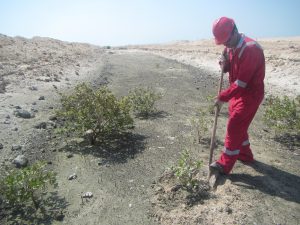Moving 300 mangrove trees in Abu Dhabi to a new home
In an unprecedented operation, a Japanese oil company operating off an island near Abu Dhabi recently excavated and moved 300 mangrove trees and saplings from a stretch of shoreline along a causeway to a new home.

The trees, which had been planted there several years ago by the oil company, had to move to make way for the construction of two new culvert systems.
The culverts will be built to improve water quality and allow exchange of fish and other marine life between the two sides of the causeway. The measure was taken last September 2019, in response to environmental requirements imposed by the Abu Dhabi Environment Agency.

‘Moving such a large number of mangrove trees in a single operations at such a scale has never been attempted before anywhere in the world to date’, Dr Erftemeijer from DAMCO Consulting explains. He was hired by the oil company to oversee the technical aspects of the operation.

Apart from some early work in Florida in the 1970s and a single study in Queensland that moved eight trees from the field into a laboratory for experimental purposes, the team had to rely on its own creativity and understanding of mangrove ecology, and hope for the best outcome.
The trees were excavated with the use of a backhoe excavator while the smaller saplings were dug up manually with the use of a spade. Since it was mid-summer, the team took extra care to minimise water loss by the plants by wrapping them in burlap during transport, pruning them before replanting and watering them with freshwater immediately after transplantation.
The new home of the trees consists of an artificial tidal channel that was dug according to specifications to ensure appropriate tidal inundation.
‘We are now monitoring the survival and growth of the translocated trees and saplings and hope to report on the preliminary outcome in about a year’s time’ Dr Erftemeijer comments.

‘Despite significant mortality within the first few months following the relocation, our monitoring results suggest promising levels of survival that are above expectation, given the harsh climatic conditions in this region’.







